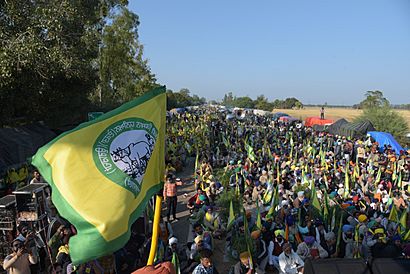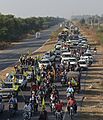2020–21 Indian farmers' protest facts for kids
Quick facts for kids 2020–2021 Indian farmers' protest |
|||
|---|---|---|---|
 |
|||
| Date | 9 August 2020 – 11 December 2021 (−1 year, 4 months and 2 days) |
||
| Location | |||
| Caused by |
|
||
| Goals |
|
||
| Methods |
|
||
| Resulted in | 250 million | ||
| Parties to the civil conflict | |||
|
|||
| Number | |||
|
|||
| Casualties | |||
|
|||
| Infrastructure damage: National highways dug up by police to stop protestors from marching to capital Over 1,500 telecom tower sites damaged (as of 28 Dec) |
|||
The 2020–2021 Indian farmers' protest was a large protest that happened in India. It started because the Indian Parliament passed three new laws about farming. Many people believed these laws would harm farmers and give too much power to big farming corporations.
Most of the farmers who protested came from the states of Punjab and Haryana. These protests lasted for over a year. On 1 December 2021, the Indian government officially cancelled the new farming laws. This was a big win for the protesting farmers.
Contents
Understanding the Farm Laws
What Were the New Laws?
In September 2020, the Indian government introduced three new laws about farming. The government said these laws would help farmers. They believed the laws would make it easier for farmers to sell their crops and get better prices.
However, many farmers and their groups disagreed. They thought the laws would actually hurt them. They worried that the new rules would allow large companies to control farming. This could make it harder for small farmers to earn a living.
Why Farmers Protested
Farmers were worried about a few main things:
- Minimum Support Price (MSP): Before these laws, the government often bought crops from farmers at a set price called the Minimum Support Price. This helped farmers know they would get a fair price for their hard work. The new laws did not guarantee this MSP. Farmers feared that without MSP, big companies could buy their crops for very low prices.
- Loss of Protection: Farmers worried that the new laws would weaken the system that protected them from big businesses. They feared they would lose their bargaining power.
- Control by Corporations: Many farmers believed the laws would let large corporations take over the farming business. They thought this would leave small farmers with little control over their own farms and incomes.
The Protests Begin
How Farmers Protested
Farmers used many peaceful ways to protest:
- Marches: Thousands of farmers marched from their villages towards Delhi, the capital city of India. They traveled on foot, in tractors, and on trucks.
- Sit-ins (Dharna): They sat peacefully in large groups, blocking roads and highways. This was a way to show their strong disagreement with the laws.
- Rallies: Farmers held big meetings and gatherings to share their concerns and gather support.
- Gherao: This is a type of protest where people surround a building or a person to show their demands.
Life at the Protest Sites
The protest sites, especially around Delhi, became like small villages. Farmers set up camps, cooked food, and even held discussions and educational sessions. They supported each other during the long protest. Many people from different parts of India, and even outside, sent food, blankets, and other help to the protesting farmers.
Government Response and Outcome
Talks and Discussions
The Indian government held many meetings with farmer leaders. They tried to find a solution and end the protests. However, the farmers were firm in their demand: they wanted the three new laws to be completely cancelled. They did not want any changes or amendments to the laws.
The Laws Are Cancelled
After more than a year of protests, on 19 November 2021, the Prime Minister of India, Narendra Modi, announced that the government would cancel all three farm laws. This was a big moment for the farmers. The laws were officially removed by Parliament on 1 December 2021.
What Happened Next?
After the laws were cancelled, farmers slowly started to leave the protest sites. They had achieved their main goal. This protest showed the power of peaceful demonstration and how people can come together to make their voices heard.
Images for kids
-
Among the demands is the removal of punishments and fines for stubble burning as well as the release of farmers arrested for burning paddy stubble in Punjab
-
Narendra Modi announcing the repeal of the three controversial laws in a televised address on 19 November 2021
See also
 In Spanish: Paro agrario de India de 2020-2021 para niños
In Spanish: Paro agrario de India de 2020-2021 para niños










